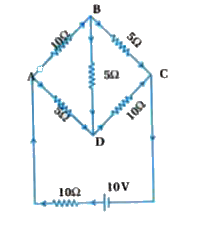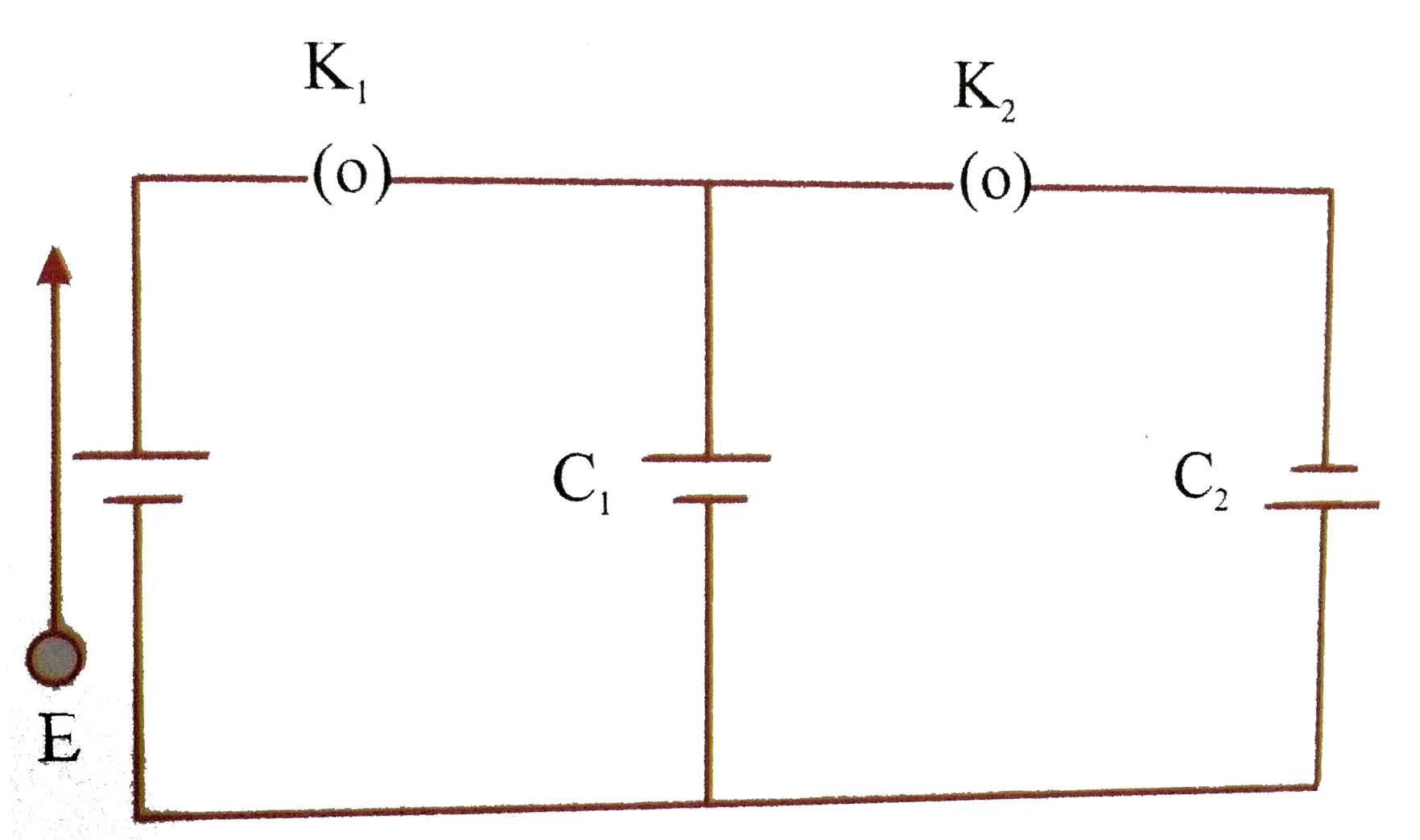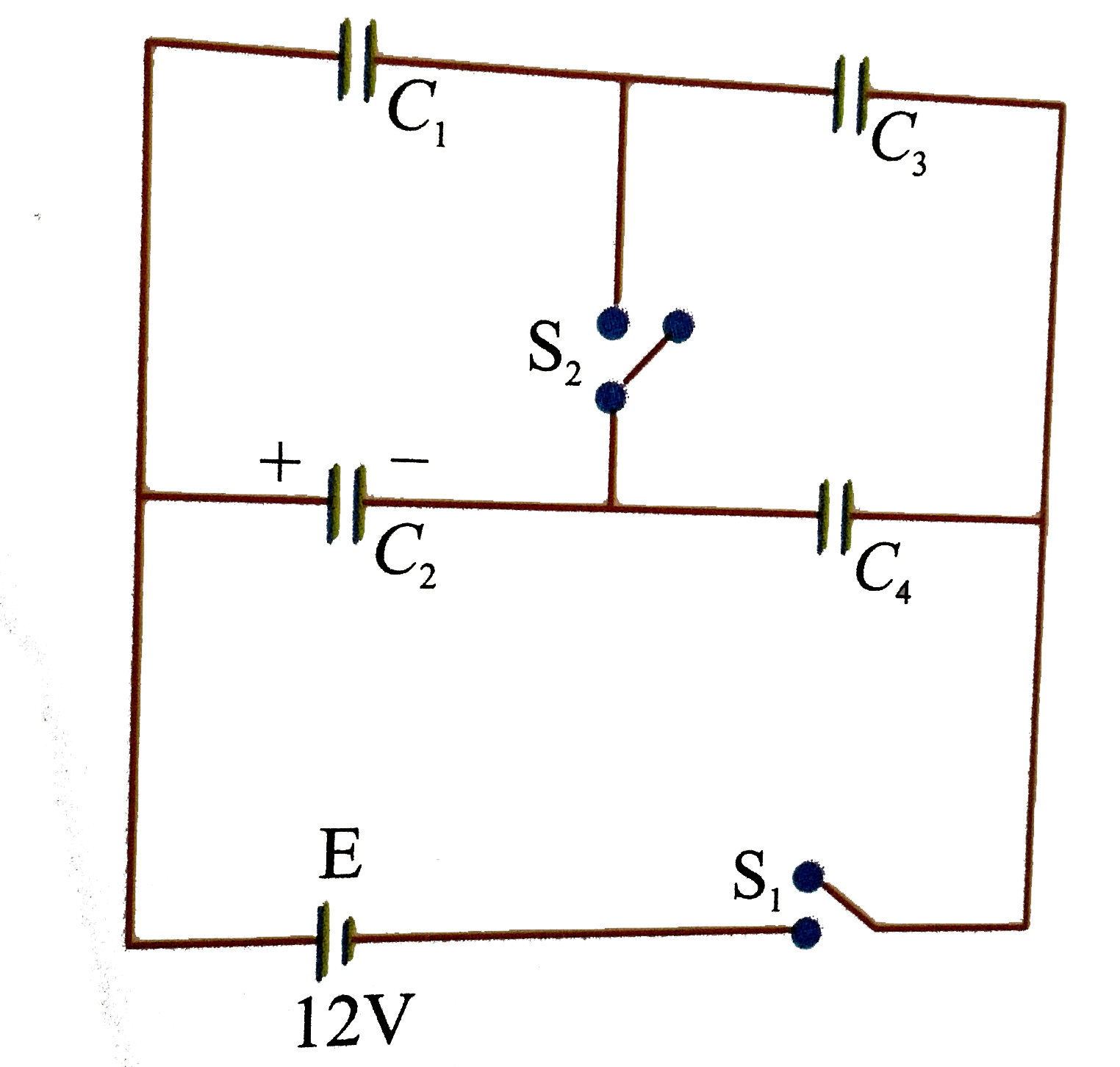In the circuit shown in figure initially key K1 is closed and key K2 is open. Then K1 is opened and K2 is closed (order is important ). Take Q1 and Q2 as charges on C1 and C2 and V1 and V2 as voltage respectively. Then,

(a) Charge on C1 gets redistributed such that V1−V2
(b) Charge on C1 gets redistributed such that Q1=Q2
(c) Charge on C1 gets redistributed such that C1V1+C2V2=C1E
(d) Charge on C1 gets redistributed such that Q1+Q2=Q
Charge on C1 gets redistributed such that V1−V2
Charge on C1 gets redistributed such that Q1=Q2
Charge on C1 gets redistributed such that C1V1+C2V2=C1E
Charge on C1 gets redistributed such that Q1+Q2=Q
The correct Answer is:A, D
When K1 is closed keeping K2 open the capacitor C1 gests charged by battery and hen K1 opens and K2 closed charge on C1 is redistributed between C1 and C2 until the potential becomes equal so V1=V2 .
Let charge on C1 is Q which is charged by battery. Now when K1 is open and K2 is closed then charge on C1 is redistributed such that the charge is conseived. Means, when charge Q.1 on C1 and Q.2 on C2 then according to law of conseivation of charge,
Q=Q1+Q2 .
Topper's Solved these Questions
- ELECTROSTATIC POTENTIAL AND CAPACITANCEBook:KUMAR PRAKASHANChapter:ELECTROSTATIC POTENTIAL AND CAPACITANCEExercise:Section C ( NCERT Exemplar Solution ) ( Very Short ,Aswer Type Questions )
Explore 5 Videos
- ELECTROSTATIC POTENTIAL AND CAPACITANCEBook:KUMAR PRAKASHANChapter:ELECTROSTATIC POTENTIAL AND CAPACITANCEExercise:Section C ( NCERT Exemplar Solution ) (Short ,Aswer Type Questions )
Explore 5 Videos
- ELECTROSTATIC POTENTIAL AND CAPACITANCEBook:KUMAR PRAKASHANChapter:ELECTROSTATIC POTENTIAL AND CAPACITANCEExercise:Section B (questions)
Explore 2 Videos
- ELECTROMAGNETIC WAVESBook:KUMAR PRAKASHANChapter:ELECTROMAGNETIC WAVESExercise:BOARD.S QUESTION PAPER MARCH - 2020 (PART - B) SECTION - C
Explore 5 Videos
- MAGNETISM AND MATTERBook:KUMAR PRAKASHANChapter:MAGNETISM AND MATTERExercise:SECTION D Multiple Choice Questions (MCQs) (MCQs asked in Competitive Exams) MCQs asked in Board Exam and GUJCET
Explore 7 Videos
Similar Questions
Consider two conducting spheres of radii R1 and R2 with R1>R2. If the two are at the same potential, the larger sphere bas more charge than the smaller sphere. State whether the charge density of the smaller sphere is more or less than that of the larger one.
View SolutionProve that a closed equipotential surface with no charge within ilself must enclose an equipotential volume.
View SolutionA slab of material of dielectric constant K has the same area as the plates of a parallel plate capacitor but has a thickless (12)d. Where d is the separation of the plates . How is the capacitance changed when the slab is inserted between the plates
View SolutionDetermine the current in each branch of the given network.

View SolutionAt a place on earth the vertical component of earth's magnetic field is √3 times its horizontal component. The angle of dip at this place is …...
View SolutionIn, the charges on C_(1),C_(2) , and C_(3) , are Q_(1), Q_(2) , and Q_(3) , respectively. .
View SolutionA circuit containing capacitors C_(1) and C_(2) shown in Fig. is in the steady state with key K_(1) closed. At the instant t = 0, K_(1) is opened and K_(2) is closed. The angular frequency of oscillation of the circuit and charge across C_(1) at t = 125 (mu)s are respectively
View SolutionIn the circuit shown in figure , initially key K1 is closed and key K2 is open. Then K1 is opened and K2 is closed (order is important). [Take Q′1 and Q′2 as charges on C1 and C2 and V1 and V2 as voltage respectively].

Then
View SolutionFour capacitors C_(1)(=1 muF),C_(2)(=2muF),C_(3)(=3muF) and C_(4)(=4 muF) are connected in a network as shown in the diagram. The emf of the battery is E = 12 V and its internal resistance is negligible. The keys S_(1) and S_(2) can be independetly put on or off. Indicate the charge on the capacitors by q_(1),q_(2),q_(3) and q_(4) respectively and the potential drops across them by V_(1),V_(2),V_(3) and V_(4) respectively. Initially both the keys are open. Then the key S_(1) is closed. Then the charges on the capacitors are.
View SolutionFour capacitors C1(=1μF),C2(=2μF),C3(=3μF) and C4(=4μF) are connected in a network as shown in the diagram. The emf of the battery is E=12V and its internal resistance is negligible. The keys S1 and S2 can be independetly put on or off. Indicate the charge on the capacitors by q1,q2,q3 and q4 respectively and the potential drops across them by V1,V2,V3 and V4 respectively.

Initially key S2 is closed. Then the key S1 is now closed. Then the charges on the capacitors are.
View SolutionFour capacitors C_(1)(=1 muF),C_(2)(=2muF),C_(3)(=3muF) and C_(4)(=4 muF) are connected in a network as shown in the diagram. The emf of the battery is E = 12 V and its internal resistance is negligible. The keys S_(1) and S_(2) can be independetly put on or off. Indicate the charge on the capacitors by q_(1),q_(2),q_(3) and q_(4) respectively and the potential drops across them by V_(1),V_(2),V_(3) and V_(4) respectively. Initially key S_(2) is open. The key S_(1) is closed and teh capacitors are charged. If now key S_(2) be closed, the charge that will flow across this key is.
View Solutionदो आवेशित चालकों की धारिताएँ क्रमशः C_(1) " और C_(2)है | उन्हें Q1और Q2 आवेश देने पर उनके विभव क्रमशः V1और V2 हो जाते है | यदि उन्हें तर से जोड़ दिया जाये तो निम्न की गणना कीजिए :
(i) उभयनिष्ठ विभव (ii) संयोजन में ऊर्जा ह्रास
View SolutionIn the circuit shown in the figure K_(1) is open.The charge on capacitor C in steady state is q_(1) .Now key is closed and at steady state charge on C is q_(2) . The ratio of charges q_(1)/q_(2) is qquad R_(1)=2Omega E
View SolutionThe potential at point D is = ....... as shown In below figure.

(a) 12(V1+V2)
(b) C1V2+C2V1C1+C2
(c) C1V1+C2V2C1+C2
(d) C2V1−C1V2C1+C2
View SolutionInitially key in the circuit shown K_(1) Is closed K_(2) Is open. Then K_(1) Is opened and K_(2) Is closed. (Order is important) Q_(1) and Q_(2) Respectively C_(1) and C_(2) Charge and V_(1) and V_(2) Potential, then
View SolutionIn the circuit shown in figure , initially key K1 is closed and key K2 is open. Then K1 is opened and K2 is closed (order is important). [Take Q′1 and Q′2 as charges on C1 and C2 and V1 and V2 as voltage respectively].

Then
View Solution

